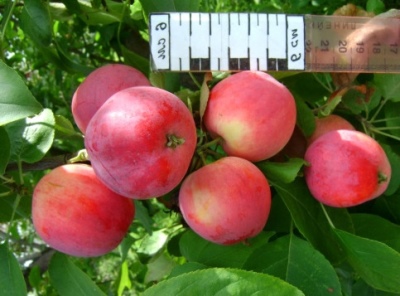
- Authors: NIISS (Barnaul), M. A. Lisavenko, I. P. Kalinina, T. V. Kornienko, Z. A. Grankina, E. S. Orekhova
- Taste: sweet and sour
- Fruit weight, g: 40-50
- Yield: at the age of 11 - 20.0 kg per tree, at the age of 13 - 31.0 kg
- The beginning of fruiting varieties: for 4-5 years
- Removable maturity: mid-August
- Keeping quality: up to 30 days
- Appointment: universal
- Growing regions: West Siberian region, Altai Territory
- Appeared when crossing: Gornoaltaiskiy х Altayskiy Dessertny
Every summer resident dreams of an apple tree, which will bring many juicy apples with a pleasant sweet and sour taste. It is for such people that there is a wonderful variety - Smuglyanka, which is also called Smuglyanochka. Tall trees and huge yields are only part of the advantages, because such a variety is suitable for both hot climates and harsh northern parts.
Breeding history
This variety was bred by Siberian scientists from the M.A.Lisavenko Scientific Research Institute of Information Systems, crossing the Gornoaltaiskaya apple tree and the Altai Dessertnaya tree together. Smuglyanka feels comfortable in the Siberian regions and almost throughout the Altai Territory. All this is due to the fact that its resistance to low temperatures, which these regions are famous for, is sufficient to bear fruit well, which allows it to bring large yields. NIISS has created many different varieties of fruits and vegetables, because it is one of the most important institutions in its environment. It was thanks to the works of scientists of this institute that varieties similar to the Dark One appeared.
Description of the variety
The crown of the tree itself is rounded, like the leaves themselves. However, they are small, dark emerald color, with a small tip. The shoots of the tree itself are shortened, curved and slightly pubescent. They are brown in color.
Features, pros and cons
The fruit is small in size, but quite juicy. The trees, which reach a height of 4.5 to 5 meters, bear fruit richly and regularly. Due to the small size of the fruits, more effort is needed to clean them, but the taste in the dishes is worth it. It is worth adding the fruit to the pie, and the filling itself will become as if tender creamy, after which a slight sour aftertaste will open.
Ripening and fruiting
The beginning of fruiting occurs in the fourth or fifth year after planting. Apples begin to appear in late July - early August. By mid-August, they are mature enough to be harvested. They can lie down for up to thirty days. If you bake or dry them, then this delicacy will lie many times longer. It is not recommended to store apples for more than thirty days, because this can lead to food poisoning or more serious consequences.
Yield
At the age of five, the tree does not produce so many apples: only up to ten kilograms per year. However, already at the age of eleven, the collection of fruits can increase to twenty kilograms. Two years later, at the age of thirteen, the tree will calmly bring over thirty kilograms of apples a year. By planting several pairs of similar apple trees, in fruitful years it is possible to provide fruit for several families until the next harvest.
Fruits and their taste
The fruits themselves are small, weighing about 40-50 grams. The color of the fruit is similar to the predawn sky, because the dark purple blush forms a bluish and thick coating, while the fruit itself is golden yellow. The shape of the fruit is oval or conical, one-dimensional, slightly oblique and ribbed. The pulp is similar to a cream cake, it has pale pink veins. The taste of apples is sweet and sour, classic.

Growing features
Given the nature of the origin of this type of variety, it must be borne in mind that in the first years it will be necessary to cut off the curved processes, otherwise there will be much fewer apples. It is also worth considering the size to which the trees grow, as this may damage power lines or roads, because the roots of this tree can come out on them.
Apple trees of this variety grow in sunny areas. It is better to take fertile soil. Watering should be moderate, mature trees are rarely watered, a couple of times per season. Top dressing is also important, especially nitrogen in early spring.



Pollination
If the bees do not pollinate the variety, then the procedure will need to be carried out independently, using special means. Pollination occurs in late spring, closer to the end of May, but no later than mid-June. If the time has passed, you need to leave the trees until next year, because if you pollinate at a too late time, the apple tree will not have time to collect all the necessary nutrients by winter and may die.



The apple tree is a popular fruit crop among gardeners. It can be found in many summer cottages. But at the same time, such trees are often affected by various diseases. It is very important to recognize the disease in time and carry out the necessary procedures for a speedy recovery. Otherwise, the fruits will be spoiled, and the tree itself may die altogether.












































































